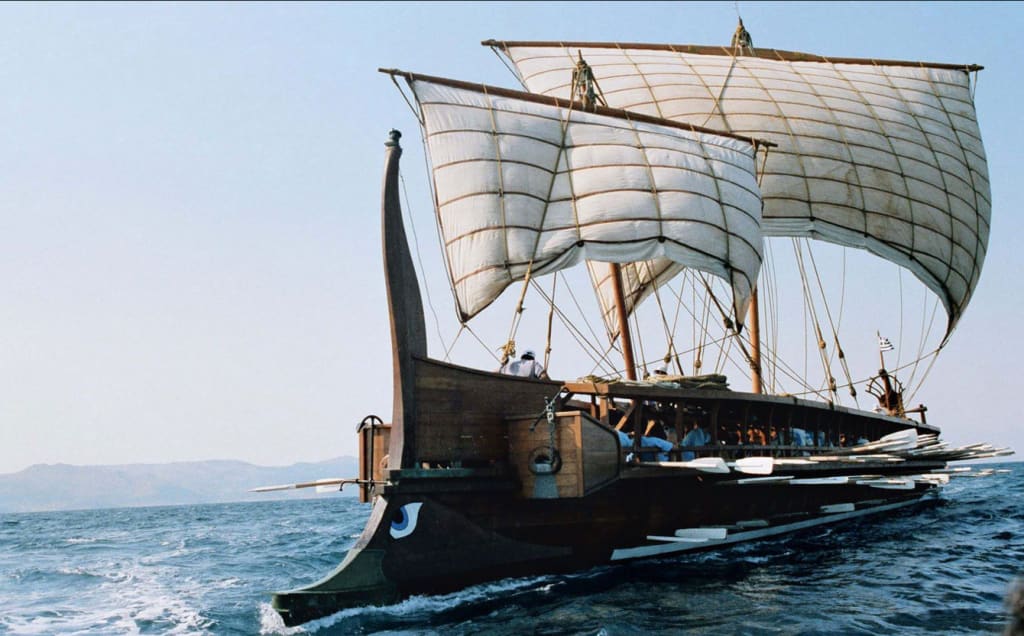Greek Trireme: The Pinnacle of Ancient Naval Warfare
History

The Greek trireme, a dominant warship in the ancient Mediterranean, epitomized the naval ingenuity and military prowess of ancient Greece. These swift and agile vessels played a crucial role in securing Greek naval dominance, particularly during the Persian Wars and the Peloponnesian War. This article explores the origins, design, strategic uses, and historical impact of the Greek trireme.
Origins and Historical Development
The trireme, derived from the Greek word "triērēs," meaning "three-oared," emerged around the 7th century BCE. It evolved from earlier Phoenician designs and became the primary warship of the Greek city-states. By the 5th century BCE, during the height of the Persian Wars, the trireme had reached its peak in terms of design and effectiveness.
The trireme's development was driven by the need for a fast and maneuverable warship capable of dominating naval battles. The Greeks, particularly the Athenians, invested heavily in their fleets, recognizing the strategic importance of naval power.
Design and Construction
The trireme was renowned for its innovative and efficient design, which included several key features:
- Three Tiers of Oars: The trireme's most distinctive feature was its three rows of oars on each side, manned by up to 170 rowers. This configuration allowed for exceptional speed and agility in the water.
- Lightweight Construction**: Built primarily from pine and fir, triremes were lightweight and narrow, enhancing their speed and maneuverability. The hull was about 37 meters (121 feet) long and 4 meters (13 feet) wide.
- Bronze Ram: At the bow, a bronze ram known as the "embolon" was used to strike and disable enemy ships. The ram was a crucial offensive weapon, designed to puncture the hulls of opposing vessels.
- Sails and Masts: While primarily powered by oars, triremes also had a single mast with a square sail, which was used during longer voyages to conserve the rowers' strength.
- Deck and Superstructure: The upper deck provided space for marines and archers, who played a vital role during boarding actions and ranged combat.
Strategic Uses and Naval Tactics
The Greek trireme was not only a technological marvel but also a vessel designed for strategic naval warfare. Its primary uses and tactics included:
- Ramming and Boarding: The main tactic in trireme warfare was ramming. Skilled helmsmen maneuvered their ships to strike enemy vessels with the bronze ram. Following a successful ram, marines would board the crippled ship to capture or destroy it.
- Speed and Maneuverability: Triremes were designed for speed, capable of reaching up to 9 knots (10.4 mph). Their agility allowed them to execute complex maneuvers, such as the "diekplous" and "periplous," which involved breaking through enemy lines and encircling them.
- Fleet Formations: Greek navies used various formations to maximize the effectiveness of their triremes. The "kyklos" (circle) and "phalanx" were common formations that provided both offensive and defensive advantages.
Historical Significance and Key Battles
The Greek trireme played a pivotal role in several key historical battles:
- Battle of Salamis (480 BCE): One of the most famous naval battles in history, the Battle of Salamis saw the Athenian-led Greek fleet defeat the Persian navy. The superior maneuverability and tactics of the Greek triremes were crucial in securing this decisive victory.
- Battle of Arginusae (406 BCE): During the Peloponnesian War, the Athenian fleet achieved a significant victory over the Spartans at Arginusae, demonstrating the continuing effectiveness of trireme warfare.
- Battle of Aegospotami (405 BCE): Conversely, the Battle of Aegospotami marked a disastrous defeat for Athens, where the Spartan fleet, also equipped with triremes, decisively ended the Peloponnesian War.
Legacy and Influence
The legacy of the Greek trireme extends beyond its historical role in warfare. Its influence can be seen in the development of subsequent naval technologies and tactics. The principles of trireme design and naval strategy informed the construction of later warships, including the Roman quinquereme.
The trireme also symbolizes the importance of naval power in shaping the geopolitical landscape of the ancient world. The emphasis on speed, maneuverability, and coordinated tactics underscored the evolution of naval warfare, setting the stage for future maritime conflicts.
Conclusion
The Greek trireme stands as a testament to the maritime ingenuity and military strategy of ancient Greece. Its innovative design and effectiveness in battle not only secured Greek naval dominance but also left a lasting impact on naval engineering and warfare. As a symbol of ancient naval power, the trireme continues to be celebrated for its role in shaping the course of history and advancing the art of war at sea.
About the Creator
Marveline Merab
“History never repeats itself. Man always does.”
― Voltaire
Enjoyed the story? Support the Creator.
Subscribe for free to receive all their stories in your feed. You could also pledge your support or give them a one-off tip, letting them know you appreciate their work.






Comments
There are no comments for this story
Be the first to respond and start the conversation.